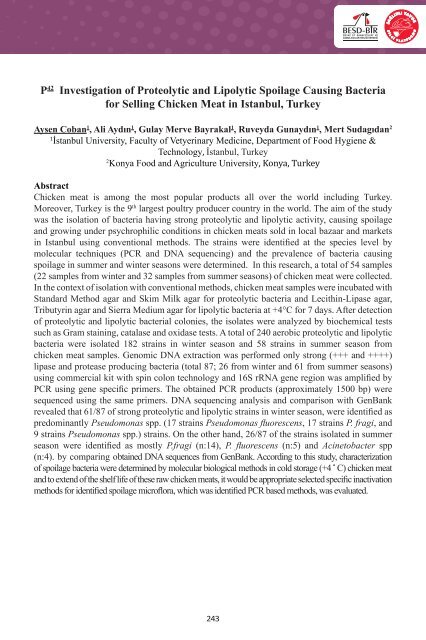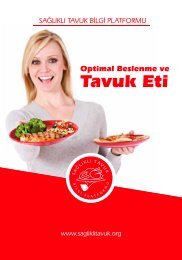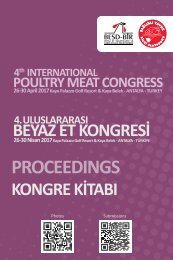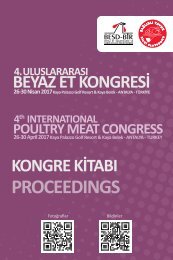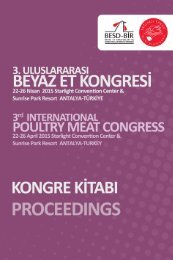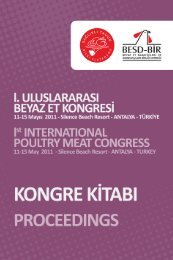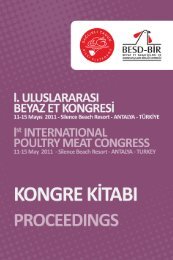- Page 4 and 5:
Healthy Chicken Information Platfor
- Page 6 and 7:
Welcome Organisation and Committees
- Page 8 and 9:
of Turkey’s most popular holiday
- Page 10 and 11:
NO O01 O02 O03 O04 O05 O06 O07 O08
- Page 12 and 13:
O35 O36 O37 O38 O39 O40 O41 O42 O43
- Page 14 and 15:
P16 P17 P18 P19 P20 P21 P22 P23 P24
- Page 16 and 17:
ORAL PRESENTATIONS
- Page 18 and 19:
improvements in genetic potential,
- Page 20 and 21:
Table 2. Summary of feed conversion
- Page 22 and 23:
Table 5. Comparisons of egg weight
- Page 24 and 25:
of 2 or more yolks at the same time
- Page 26 and 27:
18. Alvarez R, Hocking PM: Changes
- Page 28 and 29:
e the most important variable to co
- Page 30 and 31:
late incubation is considerable, ma
- Page 32 and 33:
as precursor for gluconeogenesis is
- Page 34 and 35:
References Barri, A., C.F. Honaker,
- Page 36 and 37:
USA. Romijn, C. and W. Lokhorst. 19
- Page 38 and 39:
O 04 Comparison of Some Production
- Page 40 and 41:
References: 1. Directive 2001/18/EC
- Page 42 and 43:
Animal agriculture is a major playe
- Page 44 and 45:
Figure 2:Ecological improvement pot
- Page 46 and 47:
O 07 Challenges of Animal By Produc
- Page 48 and 49:
isks or animal byproducts contamina
- Page 50 and 51:
O 08 Food Safety Based on Risk Anal
- Page 52 and 53:
O 10 Broiler Chicken Pectoral Myopa
- Page 54 and 55:
of growth, management practices tha
- Page 56 and 57:
O 11 Ventilation Basics For Modern
- Page 58 and 59:
The Moving Target: Temperature For
- Page 60 and 61:
Types of Fan-Powered Ventilation Se
- Page 62 and 63:
How Tunnel Ventilation Works The go
- Page 64 and 65:
floor. High-efficiency recirculatin
- Page 66 and 67:
Conclusion/Summary It is imperative
- Page 68 and 69:
O 13 Effect of Flock Age (27 Wk: Yo
- Page 70 and 71:
O 15 Quality Control in Vaccine Pro
- Page 72 and 73:
EU Guidelines to GMP (Good Manufact
- Page 74 and 75:
EU Guidelines to GMP (Good Manufact
- Page 76 and 77:
What is special about Salmonella ?
- Page 78 and 79:
Salmonella Legislation in the EU Re
- Page 80 and 81:
History of human Salmonella infecti
- Page 82 and 83:
Monophasic Salmonella Typhimurium -
- Page 84 and 85:
O 17 Energy Transformation of Organ
- Page 86 and 87:
POULTRY LITTER to ENERGY Biogas Fer
- Page 88 and 89:
POULTRY LITTER to ENERGY Biogas Fer
- Page 90 and 91:
POULTRY LITTER to ENERGY Biomass Ga
- Page 92 and 93:
POULTRY LITTER to ENERGY Biomass Ga
- Page 94 and 95:
POULTRY LITTER to ENERGY Biomass Co
- Page 96 and 97:
POULTRY LITTER to ENERGY Biomass Co
- Page 98 and 99:
POULTRY LITTER to ENERGY Biomass Co
- Page 100 and 101:
RESOURCE TYPE PART $ cent/kWh SOLAR
- Page 102 and 103:
POULTRY LITTER to ENERGY Legal Issu
- Page 104 and 105:
O 18 Challenges and Opportunities i
- Page 106 and 107:
O 20 Presence and Biocontrol of Lis
- Page 108 and 109:
O 22 Human Salmonellosis Attributab
- Page 110 and 111:
practices that can help the process
- Page 112 and 113:
O 24 Effects of Prebiotics, Probiot
- Page 114 and 115:
performance, some carcass and tibia
- Page 116 and 117:
Results Phytase supplementation ten
- Page 118 and 119:
Table 2. Effect of Panbonis, Phytas
- Page 120 and 121:
Table 5. Effects of Panbonis, Phyta
- Page 122 and 123:
O 27 Effect of Relative Humidity Du
- Page 124 and 125:
ut typically from 3 - 4 weeks of ag
- Page 126 and 127:
conformation and fat reserve deposi
- Page 128 and 129:
according to recommendations had be
- Page 130 and 131:
Robinson, F.E., Wilson, J.L., Yu, M
- Page 132 and 133:
O 30 Recent Developments in the Use
- Page 134 and 135:
to be essential for growth. However
- Page 136 and 137:
protein production. The next decade
- Page 138 and 139:
O 31 Nitrogen Corrected Metabolizab
- Page 140 and 141:
trial was to evaluate the interacti
- Page 142 and 143:
isoleucine, glycine, and glutamic a
- Page 144 and 145:
Table 1. Experimental design of the
- Page 146 and 147:
O 33 The Effect of Different Levels
- Page 148 and 149:
weekly higher and mean feed intake
- Page 150 and 151:
increase in dietary lysine level ca
- Page 152 and 153:
Table 2- Body Weight Gain (g) in se
- Page 154 and 155:
O 34 Effects of Genetic Selection o
- Page 156 and 157:
Table 2. Breast muscle quality of 3
- Page 158 and 159:
the basis of published information,
- Page 160 and 161:
Michelan Filho T, Rosa AF, Felicio
- Page 162 and 163:
O 36 The False Perceptions About Ch
- Page 164 and 165:
the birds are washed/rinsed and chi
- Page 166 and 167:
contaminated area might have to be
- Page 168 and 169:
Table 1 Increase in broiler process
- Page 170 and 171:
O 39 Incidence of C. perfringens in
- Page 172 and 173:
O 41 New Strategies to Improve Broi
- Page 174 and 175:
Action may include a visit to the p
- Page 176 and 177:
978 90 8686 112 4 Wageningen Academ
- Page 178 and 179:
O 43 Effect of Maternal Stress on R
- Page 180 and 181:
O 45 Further Understanding IBV is E
- Page 182 and 183:
References 1. Assayag, M. S., J. L.
- Page 184 and 185:
O 47 Rapid Detection of Infectious
- Page 186 and 187:
Consequences of heat stress Lara an
- Page 188 and 189:
Bonnett, S., P.A. Geraert, M. Lessi
- Page 190 and 191:
O 49 Effect of in ovo and Post Hatc
- Page 192 and 193:
emained outside the incubator for t
- Page 194 and 195:
in Table 5. In current study, in ov
- Page 196 and 197:
Table 1. List of treatments of Expe
- Page 198 and 199:
Table 3. Effects of in ovo synbioti
- Page 200 and 201:
POSTER PRESENTATIONS 184
- Page 202 and 203:
P 02 Effects of Early Feed Restrict
- Page 204 and 205:
% ether extract level has also been
- Page 206 and 207:
days of the trial. However, feed ef
- Page 208 and 209: P 04 Usage of Herbal (Solanum glauc
- Page 210 and 211: P 06 Decontamination of Poultry Car
- Page 212 and 213: P 08 Insects as an Alternative Feed
- Page 214 and 215: P 10 Evaluation of Feed Grade Enzym
- Page 216 and 217: P 12 Effects of Dietary Olive Leaf
- Page 218 and 219: P 14 Factors Affecting Performance
- Page 220 and 221: P 16 Effects of Breeding Age and En
- Page 222 and 223: P 18 Foot Pad Dermatitis in Broiler
- Page 224 and 225: P 20 Effects of Varying Dietary Val
- Page 226 and 227: P 22 Variation in Breast Meat Color
- Page 228 and 229: P 24 Changes in Poultry Litter Duri
- Page 230 and 231: P 26 Role of Poultry Nutrition in P
- Page 232 and 233: P 28 Economic Impact of Ectoparasit
- Page 234 and 235: in conjunction with good hygienic p
- Page 236 and 237: P 29 The Impacts of National and In
- Page 238 and 239: Housing Housing is an important cri
- Page 240 and 241: p.255. 7. Hirt, H., Hördegen, P.,
- Page 242 and 243: P 30 Estimation of Optimum Slaughte
- Page 244 and 245: P 32 Effects of Different Supplemen
- Page 246 and 247: P 34 Consumer Views for Animal Welf
- Page 248 and 249: P 36 Recent Developments in Amino A
- Page 250 and 251: P 38 Relationship Between Environme
- Page 252 and 253: oilers fed the PFA Results of the o
- Page 254 and 255: and feed conversion ratio (FCR) of
- Page 256 and 257: Table 1. Influence of diet energy l
- Page 260 and 261: P 43 Assessment of Poultry Sector i
- Page 262 and 263: Fig. 1: Mutant with retarded growth
- Page 264 and 265: Fig. 5: Isolation of Salmonella Ent
- Page 266 and 267: P 46 Does Phytase Mean just Ca and
- Page 268 and 269: This paper describes factors that i
- Page 270 and 271: Therefore, the contribution of prot
- Page 272 and 273: was a similar trend with the except
- Page 274 and 275: protease from Bacillus licheniformi
- Page 295 and 296: Notlar / Notes:
- Page 297: Notlar / Notes:


